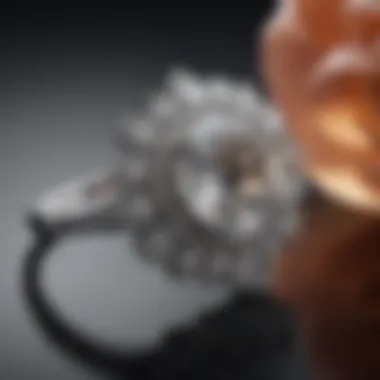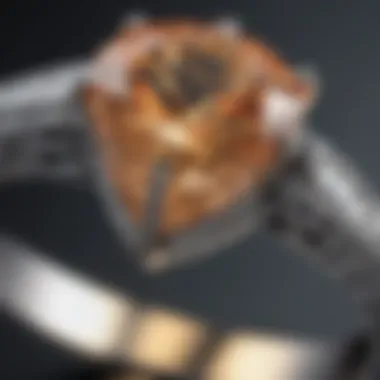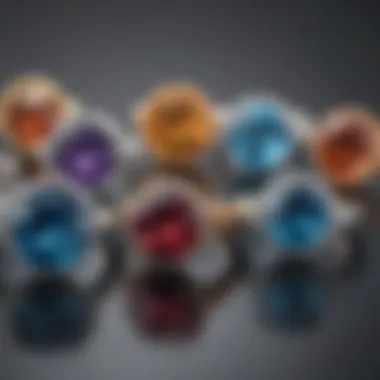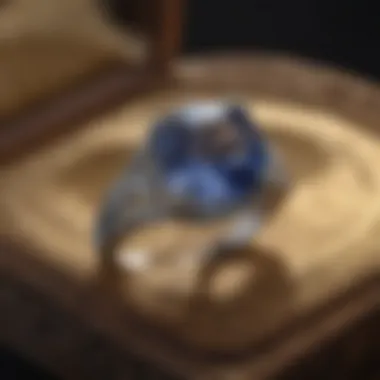Brilliant Engagement Rings: A Comprehensive Guide


Intro
An engagement ring transcends its role as mere jewelry; it is a powerful emblem of commitment and love. This article explores the intricate aspects surrounding brilliant engagement rings, focusing on various elements like their historical significance, creative designs, and material choices. Understanding these factors helps couples make informed decisions when choosing a ring, either for themselves or their partner.
In a world where sustainability and ethical sourcing are increasingly valued, the choice of gemstone and design can hold deeper meaning. Each engagement ring tells a story, often linked to the couple's unique journey. This exploration aims to highlight that significance through various lenses, appealing to enthusiasts and industry professionals alike.
Historical Context of Engagement Rings
Understanding the historical context of engagement rings is crucial in appreciating their significance today. This history reveals not only the evolution of the ring as a symbol of commitment but also broader societal attitudes toward love and partnership. By examining the origins, cultural variations, and the changes engagement rings have undergone over the years, readers can gain insights into how these pieces of jewelry have become imbued with deep emotional resonance.
The Origin of Engagement Rings
Engagement rings have a history that stretches back thousands of years. The concept likely began with a simple band, symbolizing unity and eternity. Historians often trace the origins to ancient Egypt, where rings made of braided reeds were exchanged as tokens of commitment. In ancient Roman culture, the practice evolved. Gold rings began to signify marriage, showing a shift toward more durable and valuable materials.
It's noteworthy to mention that the tradition of the engagement ring as we know it crystallized in the 15th century. The Archduke Maximilian of Austria is credited with giving a diamond ring to Mary of Burgundy in 1477. This act popularized the notion of gifting diamond engagement rings among the European aristocracy, leading to the more widespread tradition we see today.
Cultural Variations in Symbolism
Across different cultures, engagement rings hold unique meanings and traditions. For instance, in many Western cultures, diamonds are preferred. In contrast, cultures like the Chinese often use rings made from jade, believed to bring good fortune.
Not only does the material differ, but so does the context of the engagement itself. In some cultures, the engagement is a family affair, involving both families in the ceremony. In others, it is primarily a private promise between two individuals.
Understanding these variations is important for couples wishing to honor their cultural heritage. It also assists jewelry designers in creating pieces that resonate personally with their clients.
Evolution Through the Ages
As we move through history, engagement rings have consistently reflected the economic and cultural conditions of their time. The Victorian era brought intricate designs with symbols of love and devotion, like hearts and flowers. The Art Deco period introduced geometric designs and colored gemstones, emphasizing individuality and artistry.
In recent decades, the market for engagement rings has expanded, offering consumers a wider variety of styles and choices. Customization has become increasingly popular, allowing individuals to create unique pieces that hold personal significance.
Overall, the evolution of engagement rings parallels shifts in societal values and norms regarding love, marriage, and individuality. Each era's trends tell a story, showcasing the changing meanings and importance of these rings in people's lives.
This rich historical tapestry not only informs buyers about their choices but also helps in understanding the emotional weight these symbols carry.
Defining Brilliance in Engagement Rings
Understanding the concept of brilliance in engagement rings is crucial for anyone seeking to make an informed purchase. Brilliance generally refers to the quality and effect of light reflecting within a gemstone, particularly diamonds. This phenomenon influences how a ring sparkles, which significantly impacts its aesthetic appeal.
Brilliance plays a key role in the emotional resonance associated with engagement rings. A ring that appears to radiate light can evoke feelings of excitement and joy, making it a perfect symbol of love and commitment. Therefore, grasping the intricacies of brilliance allows buyers to appreciate not just the surface beauty but also the craftsmanship involved in creating these unique pieces.
What Constitutes a Brilliant Cut
The brilliant cut is a specialized diamond cut designed to maximize the gem's ability to reflect light. Each facet is precisely angled to enhance brightness and produce captivating sparkles. The traditional round brilliant cut features 58 facets, which optimally distribute light. However, variations exist, such as the princess cut or the oval cut, though their structure may differ.
Factors contributing to a brilliant cut include:
- Angle of the Facets: The specific angle affects how light enters and exits the stone.
- Symmetry: The alignment of facets ensures light reflects uniformly.
- Polish: The smoother the surface, the less light is absorbed, resulting in greater brilliance.
Engagement rings utilizing the brilliant cut often provide a dazzling display, making them a popular choice among couples.
Comparative Analysis of Diamond Cuts
Different diamond cuts exhibit unique characteristics that cater to various aesthetic preferences. The round brilliant cut is the most revered for its optical performance, yielding unparalleled sparkle. Other cuts, such as the emerald cut, may emphasize clarity over brilliance due to their larger, step-like facets.


Here is a brief comparison of popular diamond cuts:
- Round Cut: Most brilliant; best for brilliance and sparkle.
- Princess Cut: Square shape, similar brilliance, often slightly less expensive.
- Emerald Cut: Known for its rectangular shape and emphasis on clarity rather than twinkle.
- Asscher Cut: Similar to the emerald but square, also focuses on clarity.
- Cushion Cut: A vintage appeal with a blend of square and round features, offers a classic look.
Understanding these differences helps consumers choose the right option based on personal style and the significance they attach to brilliance. The right cut amplifies not only the beauty of the gemstone but also embodies the meaning behind the engagement itself.
Materials Used in Brilliant Engagement Rings
The choice of materials for engagement rings is fundamental, as it influences not only the aesthetic appeal but also the longevity and significance of the piece. Understanding the materials used allows buyers to make informed decisions that reflect personal style, ethical considerations, and budget constraints. Gemstones and metals form the cornerstone of any engagement ring, creating a blend of beauty, symbolism, and practicality.
Popular Gemstones for Engagement Rings
When selecting gemstones for engagement rings, the options extend beyond the traditional diamond. Each gemstone carries unique attributes and meanings, presenting choices that can resonate more deeply with individual tastes and values. Popular gemstones include:
- Diamonds: Known for their exceptional hardness and brilliance, diamonds remain the most sought-after choice. Their clarity, cut, carat weight, and color define their appeal.
- Sapphires: Available in various colors, sapphires offer a beautiful alternative. They symbolize wisdom and nobility. Blue sapphires, in particular, have become popular in many engagement rings.
- Emeralds: Recognized for their vibrant green hues, emeralds signify love and rebirth. However, they require careful handling due to their relative softness compared to diamonds.
- Rubies: Known for their deep red color, rubies symbolize passion and love. Their rarity adds to their allure, making them an excellent choice for romantic connections.
- Moissanite: Often seen as a lab-created alternative to diamonds, moissanite is gaining popularity for its brilliance and ethical credentials. It offers an impressive sparkle at a lower price point.
Each of these gemstones has characteristics that make them suitable for engagement rings, depending on personal preference, lifestyle, and symbolism.
Metal Choices: Gold, Platinum, and Alternatives
Metals play a critical role in engagement ring durability and overall appearance. The choice of metal affects not only the ring's aesthetic but also its comfort and maintenance requirements. Popular metal choices include:
- Gold (Yellow, White, and Rose): Gold is classic and versatile. Yellow gold gives a traditional look, while white gold offers a modern touch. Rose gold, with its blush tones, adds a romantic feel to the design.
- Platinum: Highly durable and hypoallergenic, platinum is a premium metal choice. Its naturally white sheen complements the most brilliant of stones. It does require regular polishing to maintain its appearance but is cherished for its resilience.
- Palladium: A member of the platinum group, palladium shares many characteristics with platinum. It is lightweight, resilient, and offers a whiter tone, suitable for contemporary designs.
- Titanium and Cobalt: These metals are often used for their strength and lightweight properties. They are increasingly popular among those seeking a unique style. Both hold up well against wear but may not offer the same traditional aesthetic as gold or platinum.
Choosing the right material is essential in creating an engagement ring that fulfills both emotional significance and practical use. Each option carries weight in establishing the identity of the ring, ensuring it is both a memorable and durable symbol of commitment.
"The material choices for engagement rings not only reflect personal style but also encompass ethical considerations that are increasingly important to today's buyers."
In summary, when considering engagement rings, take the time to explore diverse material options. Each material type introduces various implications for wearability, symbolism, and sustainability.
Design Trends in Engagement Rings
Design trends in engagement rings reflect the evolution of personal tastes and societal values. These trends are not merely aesthetic; they also encompass meaning and identity. Understanding the current styles can help couples articulate their unique love story through their chosen ring. In addition, these trends may influence purchasing decisions, as buyers often seek rings that resonate with contemporary ideals, whether they be vintage elegance or cutting-edge design.
Classic vs. Contemporary Styles
Classic designs have always held esteemed value in the world of engagement rings. They often highlight timeless elements such as solitaire settings or intricate vintage designs. Rings featuring round brilliant cuts and traditional settings like prongs maintain their popularity for their understated elegance.
Conversely, contemporary styles express creativity and uniqueness. These rings may feature unconventional shapes, asymmetric designs, or alternative gemstones. Couples who opt for contemporary rings often desire to make a statement about their individuality or differentiate themselves from traditional norms. Mindfully blending both classic and contemporary can yield a personal style that stands out while still respecting timeless beauty.
Personalization and Custom Designs
Personalization in engagement rings has gained significant traction. Many couples are now opting for bespoke designs that reflect their shared journey. Custom rings allow for elements that signify personal stories or values. For example, incorporating meaningful symbols or birthstones can create a deeper connection between the ring and the relationship.
The process of designing a custom engagement ring often involves collaboration with skilled jewelers. This gives buyers the benefit of expert insight into selecting materials and styles that enhance the overall vision of the ring. While this option may come at a higher price point, the emotional value and uniqueness of a personalized piece can outweigh the cost.
"An engagement ring is more than just a piece of jewelry; it is a profound symbol of commitment, and customizing it makes the emblem even more intimate."
Opting for a personalized design reflects significant cultural shifts. Couples today prioritize personal expression over convention. This trend speaks to a desire for authenticity in critical life milestones. Therefore, those looking into engagement rings are encouraged to find or create designs that resonate deeply with their unique stories.
The Significance of Ethical Sourcing
The topic of ethical sourcing in the context of engagement rings resonates deeply with contemporary values concerning social and environmental responsibility. As consumers become more informed, the importance of knowing where and how gemstones are obtained is gaining traction. Ethical sourcing assures that the materials chosen are not only beautiful but also responsibly mined and traded. It reflects a commitment to sustainability and ethical practices, adding intrinsic value to the ring that goes beyond its physical appearance.
When considering an engagement ring, the implications of ethical sourcing impact several aspects:


- Environmental Impact: Sustainable mining practices aim to minimize ecological damage. This contrasts sharply with traditional mining, which often leads to deforestation and pollution.
- Human Rights: Ethical sourcing prioritizes fair labor practices. This ensures that miners work under safe conditions and receive fair wages.
- Consumer Awareness: Educated consumers are now prioritizing brands that disclose their sourcing practices. This trend encourages the industry to adopt more responsible methods.
"Investing in ethically sourced rings not only symbolizes personal commitment but also supports global efforts towards fairness and sustainability."
Understanding Conflict-Free Diamonds
Conflict-free diamonds are those that are sourced without funding conflict or human rights abuses, particularly in war-torn regions. The concept emerged in response to the diamond trade's notorious connection with financing violence, especially in Africa. The Kimberly Process was established in 2003 to certify that diamonds are conflict-free. However, its effectiveness is sometimes debated, necessitating further consumer vigilance.
When selecting conflict-free diamonds, buyers should consider:
- Certification: Look for diamonds with certifications from reputable sources like the Kimberley Process, the Responsible Jewelry Council, or Fair Trade.
- Transparency: Brands should provide clear information about their sourcing practices.
- Alternatives: Consider lab-grown diamonds as a conflict-free option that has minimal environmental impact.
Benefits of Choosing Conflict-Free Diamonds
- Promotes ethical consumption.
- Supports socially responsible businesses.
- Reduces the risk of contributing to human rights abuses.
Sustainable Gemstone Practices
Sustainable gemstone practices involve methods that emphasize ecological balance and equitable treatment of workers. This concept extends to all types of gemstones used in engagement rings, not just diamonds.
To promote sustainability, consider the following practices:
- Eco-friendly Mining: This includes techniques that minimize environmental footprint, such as reducing water usage and protecting surrounding ecosystems.
- Local Sourcing: Buying from local artisans can support community economies and reduce transportation emissions.
- Recycled Materials: Using recycled metals and stones can significantly lower the demand for newly mined resources.
Advantages of Sustainable Practices
- Protects the environment for future generations.
- Enhances community development by supporting local initiatives.
- Encourages innovation in the jewelry industry, leading to more thoughtful designs.
These elements combine to create a message that resonates with today's discerning consumers. Opting for ethically sourced engagement rings does not only celebrate love; it also reflects a deep commitment to responsible jewel crafting.
Purchasing Considerations for Engagement Rings
The journey of purchasing an engagement ring is significant and often daunting. This piece serves as a resource to guide you through the complexities involved in deciding upon this important symbol of commitment. Understanding the right considerations is crucial for making an informed purchase that aligns with your preferences and values. Let’s delve into two main areas of focus: budgeting and evaluating quality.
Budgeting for an Engagement Ring
When it comes to budgeting for an engagement ring, many feel overwhelmed by the expectations society places on costs. However, establishing a budget is paramount. A clear budget helps to narrow choices and facilitate comparisons. Here are some important considerations:
- Know your financial situation: Assess your current finances to determine an appropriate amount you can spend without straining your budget.
- Set realistic expectations: Avoid adhering to common myths that suggest spending two or three months' salary. Remember, the ultimate goal is to choose a piece that reflects your love story, not your bank account.
- Consider future expenses: Planning for a wedding, honeymoon, and other related costs is key. Ensure the ring fits within a broader financial plan.
Consequently, preparing a budget will guide your choices and relieve potential stress while shopping, allowing you to select a ring that is not only beautiful but also affordable.
Evaluating Quality: The Four Cs
Quality evaluation is integral to purchasing an engagement ring. The Four Cs—Cut, Color, Clarity, and Carat weight—serve as the foundation for assessing diamond quality and play a pivotal role in determining overall value.
- Cut: This refers to how well a diamond reflects light. A well-cut diamond will exhibit brilliance and sparkles. The cut affects the overall aesthetic appeal and value significantly.
- Color: Diamonds are available in various colors, with the most sought after being colorless diamonds. Typically, clearer stones carry a higher price tag. Understanding the color grading scale, which ranges from D (colorless) to Z (light yellow), assists in choosing the ideal stone.
- Clarity: Clarity evaluates the presence of imperfections, both internal and external. A higher clarity grade indicates fewer flaws, enhancing the gemstone’s value and appearance. Most diamonds come with some inclusions; understanding these is vital for informed buying.
- Carat: This measurement indicates the weight of the diamond. Larger diamonds can be considerably more expensive, yet the perception of size is impacted also by the cut and shape. Choosing the right carat should align with personal preference and budget.
By grasping the Four Cs, buyers can make educated decisions on which diamonds meet their needs.
"Understanding diamond quality is about more than just aesthetics; it is a comprehensive evaluation that influences your purchase."
Overall, approaching the purchase of an engagement ring with thoughtful consideration of budget and quality will help ensure that you make informed decisions reflecting both your financial situation and personal desires.
Caring for Your Engagement Ring


Caring for your engagement ring is essential to maintain its brilliance and integrity over time. Given that these rings symbolize profound emotional bonds, ensuring that they remain in pristine condition is a reflection of the commitment they represent. Routine care not only enhances the aesthetic appeal of the ring but also safeguards its structural integrity against wear and tear. Understanding the nuances of proper ring maintenance can help you enjoy your precious item for many years.
Routine Maintenance Tips
Maintaining an engagement ring should be a regular practice rather than an occasional task. There are several straightforward actions you can take to keep the ring looking its best:
- Regular Inspection: Check the ring periodically for loose stones or damage. Look closely to see if the mounting has remained secure.
- Gentle Cleaning: Use a soft-bristle toothbrush with mild soapy water to clean the ring. Make sure to rinse it thoroughly to avoid soap residue.
- Avoid Harsh Chemicals: When cleaning, avoid bleach or any abrasive cleaners, as these can damage the metal and stones.
- Store Properly: When not wearing your ring, store it in a fabric-lined box or a soft pouch to prevent scratches. Keeping it separate from other jewelry can also help avoid damage.
- Wear Responsibly: Remove the ring before engaging in strenuous activities, such as exercising or doing household chores, to protect it from potential damage.
By integrating these habits into your routine, you can prolong the life and beauty of your engagement ring.
When to Seek Professional Cleaning
While routine maintenance is crucial, sometimes professional care is necessary to preserve the ring's beauty effectively. Here are some situations when it might be the right time to seek professional cleaning:
- Deep Cleaning Required: If your ring has accumulated significant dirt or oils that normal cleaning cannot remove, it might be time for a deeper clean.
- Annual Maintenance: Many jewelers recommend taking your engagement ring in for professional cleaning at least once a year to inspect for any issues and restore the shine.
- Before Special Occasions: If you have an important event coming up, a professional cleaning can help the ring regain its brilliance.
- After Exposure to Harmful Substances: If the ring has been exposed to harsh chemicals or harsh environments, a jeweler can help assess and clean the ring appropriately.
Seeking professional assistance ensures any issues are identified early, allowing for timely repairs and maintenance. Keeping your engagement ring in optimal condition reflects the significance it holds.
Emotional Resonance of Engagement Rings
Engagement rings hold a profound emotional weight, serving purposes that transcend their physical attributes. They are more than aesthetic adornments; they represent the commitment between two people. This symbolism fosters strong connections and shared histories. Such emotional depth is essential in understanding the role of engagement rings in modern society.
Symbolism of Commitment
The core function of an engagement ring is to signify commitment. This is more than tradition; it is a promise of love and fidelity. When someone presents an engagement ring, it signifies intentions for a shared future. The act of giving an engagement ring encapsulates the emotional stakes of marriage and eternal companionship.
Many people view the ring as a physical manifestation of their love story. The gemstone and its setting echo the individuality of the couple and their unique journey together. The choice of stone, size, and design can evoke cherished memories or represent aspirations for the future. In this way, the ring becomes a personal talisman.
"An engagement ring is not just a piece of jewelry; it is a story waiting to be told, a symbol of dreams intertwined."
Cultural Perspectives on Love and Marriage
Different cultures provide varying interpretations of engagement rings. In some societies, the engagement ring is an essential component of the wedding ritual. For instance, in Western cultures, diamond engagement rings are popular because diamonds symbolize durability and rarity.
In other regions, gems like sapphires or emeralds may hold more significance. This reflects local beliefs about love and the qualities that define enduring relationships. The choice of gemstone can thus convey messages about devotion and fidelity.
Additionally, the practice of giving and receiving engagement rings can vary widely. Some cultures emphasize the groom's family providing the ring, while others see it as a shared responsibility. This diversity illustrates how cultural heritage shapes the meanings assigned to rings and relationship commitments.
Finally, in today's globalized world, new traditions emerge. Couples now often design their rings together, moving beyond historical norms. This trend reflects changing attitudes towards marriage and individuality, asserting that love's expression can be as unique as the couple's journey.
Future Trends in Engagement Rings
Engagement rings continue to evolve, reflecting not just individual preferences but also broader societal shifts. As couples seek more personalized expressions of their commitment, staying informed about future trends in engagement rings becomes crucial. Awareness of innovative gemstone choices and technological advancements enables buyers to make decisions that resonate with their values and aesthetic sensibilities.
Emerging Gemstone Choices
The choice of gemstones used in engagement rings is diversifying beyond traditional diamonds. More couples are embracing alternative gemstones that reflect personal beliefs and preferences. For instance, sapphires, rubies, and emeralds have gained popularity, each offering unique characteristics and hues.
- Sapphires: Known for their durability and range of colors, particularly stunning blue hues.
- Moissanite: A lab-created stone that exhibits brilliance and fire comparable to diamonds but at a lower cost.
- Lab-Grown Diamonds: These provide an ethical alternative with nearly identical qualities to natural diamonds, appealing to environmentally conscious buyers.
Consumer interest is also shifting towards gemstones like morganite, which provides a soft, pink hue or even unique stones like tanzanite and alexandrite, which change color under different lighting. The emotional resonance and symbolism behind these choices may enhance their significance, making them more than just decorative pieces.
Technological Innovations in Ring Design
New technologies are playing a significant role in the customization and design processes of engagement rings. Techniques like 3D printing and advanced CAD (computer-aided design) allow for a higher level of precision and creativity.
- 3D Printing: This technology enables designers to create intricate designs that were previously difficult or impossible to produce. Customization becomes more accessible, allowing individuals to craft a ring that truly represents their love story.
- CAD Software: With CAD, individuals can visualize their ring choices more effectively, experimenting with various styles, settings, and gemstones before the actual creation begins.
Through such innovations, the process of designing an engagement ring is more collaborative and personalized. Couples can engage in creating a piece that feels uniquely theirs, fostering a deeper connection with the object.
In summary, the future trends in engagement rings reveal a shift towards individuality and sustainability. By choosing alternative gemstones and embracing current technological advancements, couples can ensure their engagement rings are a true reflection of their values and commitment.







